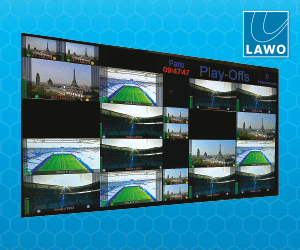Mohamed El Sehrawys film For Granted won the Sony PROduction award this year. Vibhuti Arora caught up with the filmmaker to learn about the making of his first short Photographer and filmmaker Mohamed El Sehrawy recently won the Sony PROduction Award for his short For Granted, which was inspired by a photo shoot he had […]
 Mohamed El Sehrawys film For Granted won the Sony PROduction award this year. Vibhuti Arora caught up with the filmmaker to learn about the making of his first short
Mohamed El Sehrawys film For Granted won the Sony PROduction award this year. Vibhuti Arora caught up with the filmmaker to learn about the making of his first short
Photographer and filmmaker Mohamed El Sehrawy recently won the Sony PROduction Award for his short For Granted, which was inspired by a photo shoot he had conducted to expand his portfolio. El Sehrawys penchant for photography becomes evident in his film For Granted.
El Sehrawy worked as a freelance photographer, a photography instructor and, very briefly, as a budget filmmaker in Cairo, before moving to London to study film. He is presently taking a Bachelors Degree course in filmmaking at the MET Film School in Ealing Studios in London, which he is due to complete in 2015.
Al Sehrawys interest veered towards filmmaking after a very interesting encounter with a mannequin. While working on his portfolio, he ended up using a mannequin as the lead model for his shoot. What followed was a short film, which was originally made with the idea of entering a competition but formally introduced El Sehrawy to filmmaking. It was a two-minute film that revolved around a mannequin.
Back in Cairo, he was constantly updating his Facebook photography page, which is called Sehrawys Photography, with his latest photos.
Talking about his first steps in the world of filmmaking, El Sehrawy explains that it started quite by chance: The number of fans kept on growing on my Facebook page. Now, it is more than 15,000 people on my page. One day, I posted a photo and it was shared on Facebook homepages of my friends and cousins.
Stylist Nada Abudahab, who was friends with my cousins, saw the post and approached me to shoot for her.
Abudahab was working in Dior London at that time and wanted to pursue a photography project for her designs and costumes. She was travelling to Alexandria, Egypt for the project and invited El Sehrawy to join her. It was going to be a joint project, where she designed and styled and I did the shooting.
We were required to work with models for the project, which unfortunately or rather fortunately did not happen. We couldnt find a professional/competent model that was up to the standards we were looking for. We decided to use a mannequin instead. I called that mannequin Yolanda, explains El Sehrawy.
The name Yolanda was inspired by Yolanda Reef, a beautiful reef off the coast of Ras Muhammad in Sinai, Egypt.
Its very popular among scuba divers who flock to Yolanda Reef from all around the world. As a diver, El Sehrawy considers Yolanda Reef as one of the milestones of beauty.
Yolanda was an old and distressed mannequin that they found in a warehouse. Before the shoot, they sanded and spruced it up to give it the desired look.
At that time, I had no clue that my relationship with Yolanda would go further and I would shoot my very first film with her, he adds.
After spending an entire day shooting in a villa in Alexandria, El Sehrawy and Abudahab shortlisted nine photographs for their respective portfolios. The same were later published in Volt Magazine, London.
After the success of this project, Nada and I talked about how one day we should create a short film starring a mannequin and try to get it as expressive as possible. Thats how it all started, he adds.
I began my career as a photographer and as I move on to films, I realise deep down my sensibilities still are and will always be that of a photographer, explains the filmmaker.
Sehrawy intends to make meaningful films, and his bigger dream is to bring respect back to Egyptian cinema.
I want to become a credible director and use my knowledge and relative influence to aid in the rebirth of cinema in the Middle East, more specifically in Egypt, he says.
Historically, Egypt has been a hub for cinema in the Middle East but the industry has not progressed as desired in recent years.
The history of Egyptian cinema goes back many years, but for the past few years, the industry has been ailing because of the political turmoil and a lack of fresh perspective.
Egypt is home to monumental wealth in classic cinema and art. As Im sure most film buffs know, the film industry has the potential to positively impact a countrys economy and thus, its people. However, this industry is like a double-edged sword. It must be treated with competence, balance, respect and talent. If you do it right, you will add a lot of value to yourself, to the economy and to others. Do it wrong, and you wont stand a chance against the fierce global competition, he explains.
El Sehrawys award-winning short revolves around two mannequins, and has no actors.
There are no humans in my film. Instead, my film stars a couple of mannequins. The entire story of the film is expressed through camera movement, light and music, says the filmmaker.
The film is a black-and-white silent, symbolic film that serves as a reminder to our egos that we must learn to stop taking things for granted, explains El Sehrawy.
For Granted was El Sehrawys first independent film, which he made especially for the Sony PROduction competition. The film was made on a shoestring budget with minimal crew. He used his monthly allowance to fund the film. His fellow students and friends helped him execute the project.
Nada Abudahab, who is a friend helped me on the film with costumes. Alexander Aked, Dennis Murickan, Paul Lambert and Tedd Beam are my classmates to whom Im deeply grateful. If it werent for their help, I would never have been able to finish the film on time, he says.
The post production and editing did not involve too much expertise either.
The only thing I did was cut and stitch the shots together. I dont think that counts as post production. Funnily enough, thats what film making essentially is cutting and stitching till you get the desired result. So, my film is symbolic at more than one levels. What we see in the film is what we shot explains the filmmaker.
There is no CGI in the film, no effects whatsoever, and no alteration in colour or contrast. The film was shot in black and white and in the contrast and sharpness that is seen in the film.
What the viewer sees in the film is shot using a Sony NEX-6 camera without any major processing involved. The text and music were added later.
He did not use a written script but made the entire film purely based on instinct. He confesses that he did not see the need for a written script.
There was no ambiguity, as I knew exactly what I wanted. The film was an offshoot of my photography and a
script was redundant, so to speak,
he explains.
El Sehrawy bought a Sony NEX-6 camera for the purpose of creating this film, which was mainly produced to enter the competition.
I had invested in several quality lenses but never had the chance to buy a film camera. So I decided to go for the NEX-6 since it allows me to use all my lenses. While that was a big attraction for me, this camera also generates the quality I was looking for. I thought, it being lightweight and compact also helped me in making the decision, he says.
He is quick to add though that the camera is just a tool and should not be the mainstay of a film project.
My advice to people is to never dwell on which camera is being used. It is never about what you have. It is about how you use what you have. Theres no such thing as a good camera or a bad camera. Theres only such a thing as you; the person behind the camera. Youre all that matters, he comments.


































































